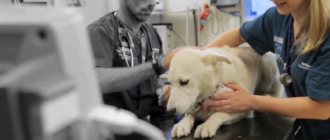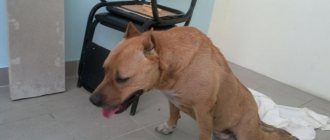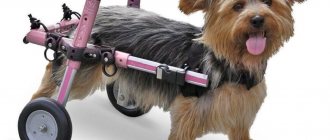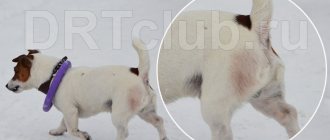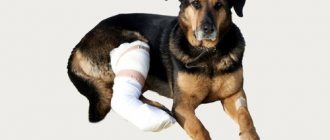Dogs can suffer from lameness due to a variety of reasons. To understand why dogs lame, you need to do the following.
1. Examine the limbs of a lame dog
If your dog is limping on one leg or another, inspect it carefully. There may be injuries on the paws such as cuts, insect bites, damaged claws and soft tissue bruises, and pebbles and other sharp objects may get stuck between the toes. If you have the latter case, then it is best to remove the object located between the animal’s fingers with tweezers, and this should be done in a well-lit place. If an object is lodged under the skin, the dog should be taken to the vet.
2. Feel the limbs
If during the examination you received little information, you need to feel the animal’s paws to understand where it is experiencing pain. All dogs react differently to pain. Some growl, others whine, and others bite. If you have an aggressive dog who bites, you should not touch his sore or lame paws. If the limb is swollen and the bones are irregularly shaped, this may indicate a fracture and should only be treated by a veterinarian.
3. Take the dog to the vet if the cause of the lameness cannot be identified.
If you are able to help the dog yourself, you can try. If not, take your dog to the vet. Read: Cure lameness in a dog >>>
The animal must be taken to the clinic even if it is limping, and the cause of its lameness cannot be identified. There he will be x-rayed and diagnosed. Sometimes lameness can occur due to systemic diseases that you still cannot visually and touch.
Random causes of lameness in dogs
Besides cuts, damaged nails, and pebbles getting stuck between toes, there is a whole list of other causes of canine lameness. If the animal was hit by a car, played too intensely or ran a lot, it may begin to limp, but most likely it will not be possible to immediately determine the reason. In this case, she may have the following injuries. 1. Sprains
Dogs, like people, can suffer muscle or ligament strains. This occurs with sudden movements during games and other vigorous activities. Most sprains go away within 48 hours. If after this time the dog is still limping, it should be taken to a veterinarian. He will identify the real cause of lameness and prescribe anti-inflammatory drugs to relieve pain. Early treatment promotes faster recovery from injury.
2. Fractures Fractures are usually visible immediately. The leg does not support the weight of the dog. It is clear that the animal is in severe pain. The leg is deformed, and sometimes the bones protrude outward. In some cases, severe bleeding is possible, which is important to stop as quickly as possible. In this case, the dog must be urgently taken to the clinic, where it will undergo surgical treatment. It is important that the animal does not move after receiving a serious injury. But fractures do not always occur due to injury. Sometimes they occur during dog bone cancer.
Boxer dog
3. Growing Lameness Large young dogs often experience leg problems as they grow. This happens to them, most often, at the age of 2 months. up to 2 years. Too much growth in the dog's body creates a lot of stress on the still fragile bones. The cause of lameness may be too high-calorie food, incorrect proportions of protein, calcium and phosphorus in it.
In what cases is a visit to the veterinarian necessary?
If the dog owner has followed all the recommendations, but the pet’s tremors have not stopped for several days, then you need to see a veterinarian. Drowsiness, lethargy, whining, refusal to eat, weakness - all this indicates the presence of some kind of disease in the animal, so you cannot do without a doctor. Sometimes trembling is the main symptom of deadly illnesses.
Depending on the disease, the veterinarian may prescribe different treatments:
- hyperimmune serum, immunostimulants and vitamins are used to treat viral hepatitis;
- dirofilariasis is a very terrible disease, and ivomec, filarsen and thiacetarsamide are used to treat it;
- parvovirus enteritis is treated with immunoglobulins and hyperimmune serum;
- if the brain is damaged, a compress, massage, vitamins and antibiotics are needed;
- To get rid of helminths, you can use various antiparasitic agents.
Situations vary, but in most cases, tremors are caused by external stimuli, and not by serious diseases.
When trembling is accompanied by dangerous symptoms, and the animal looks sick and lethargic, there is no need to postpone a visit to the doctor. After all, you can miss precious time when the dog can still be successfully rehabilitated. It’s better to visit the veterinarian once again and hear that nothing bad happened, everything will pass. Take care of your pets and let them always make you happy.
Other Causes of Lameness in Dogs
Although young dogs may experience lameness as they grow, older dogs may have other causes. Both the front and rear legs can be affected. 1. Front Leg Lameness - Elbow Dysplasia In this case, the dog will limp and experience pain when the elbow joint area is stretched. Sometimes the pain can be so severe that the animal loses the ability to use the limb.
2. Lameness of the hind legs
Cane Corso dog
— Hip dysplasia
The hip joint consists of a head and a socket. With dysplasia, due to structural defects, the head does not fit properly into the socket, which causes corresponding sensations. In dogs, hip dysplasia is a genetic disorder. All dogs must be tested for this defect before breeding. Large dogs with dysplasia have difficulty walking and lying down.
– Anterior cruciate ligament rupture Sometimes the dog turns on its hind legs. This can cause rupture of the cruciate ligaments. It can also happen if a dog moves on any surface or is hit by a car. The most common causes of cruciate ligament rupture are Newfoundlands, Labrador Retrievers, Rottweilers, and St. Bernards. The affected dog will typically be lame, and the affected joint may be swollen.
– Habitual luxation of the patella
If your dog is experiencing pain in the kneecap area, it may be due to a subluxation of the kneecap. This condition is common in small breed dogs such as Yorkies, toy poodles, and dachshunds. The problem often manifests itself when the dog is running.
Labrador dog
– Bone Cancer Large breed dogs are often susceptible to bone cancer, which can cause them to develop severe lameness and unexplained fractures from even minor injuries. Bone cancer is a very serious disease that can result in an animal having a limb amputated to relieve pain.
dog German Shepherd
– Arthritis
As dogs age, continued friction causes their joints to become inflamed and arthritis occurs. Arthritis most often affects middle-aged or older dogs. Animals have difficulty jumping out of a car or climbing stairs. They experience more severe pain in the morning, so they walk more slowly at this time of day. Anti-inflammatory drugs are very helpful in treating the disease. You can also use home remedies to treat arthritis. – Lyme disease
This disease occurs after a tick bite. A few months after a tick bite, the dog begins to limp for no apparent reason. True, in the initial stage of the disease, lameness may be barely noticeable. When the process reaches its peak, the dog will no longer be able to walk. Lyme disease lameness may be accompanied by fever and lethargy. The disease responds well to treatment with antibiotics such as doxycycline or cephalexin.
Newfoundland dog
So, as you can see, there can be a great many reasons for lameness in dogs. Despite the information contained in this article, you do not need to diagnose your dog yourself. The only way to find out the cause of her lameness is to take your dog to the vet for x-rays and other tests.
Pitbull dog
Differential diagnosis and special methods
Muscle tremors and cramps accompany various conditions in animals. It is necessary to differentiate nervous conditions (damage to the membranes of the brain) from fear, hypothermia, and a number of infectious diseases. The diagnosis is established on the basis of additional laboratory and instrumental studies.
An important point in making a diagnosis and choosing treatment is to establish the etiological factor that led to epileptic seizures:
- congenital primary pathologies;
- brain diseases;
- compensatory function of the brain when other organs are damaged.
The clinical picture of seizures in a dog depends on the location and extent of the area of increased activity. A generalized epileptic seizure is characterized by bilateral inflammation of the muscles. All muscles of the body are affected. The dog is trembling and lethargic, breathing frequently, and may lie down for a long time. The dog tucks its tail to its body and is in a faint state.
Idiopathic inflammation of the cerebellum in dogs is practically not detected by laboratory tests. Blood biochemistry indicators and urine tests are within the physiological norm. Minor changes are detected when taking a cerebrospinal fluid puncture - a moderate increase in lymphocytes and monocytes.
The nature of seizures in various pathologies:
- diseases of the nervous system are characterized by the periodic occurrence of attacks;
- in case of poisoning, tremor is gradually replaced by strong clonic convulsions (convulsions);
- with catalepsy, constant cramps of one or two legs appear;
- Myoplegia is characterized by repeated relaxation of the muscle tone of the limbs;
- a nervous tic is accompanied by rhythmic twitching of the paws.
Epilepsy in dogs should be distinguished from fainting. An epileptic seizure is preceded by an attack of strong involuntary muscle contractions. Involuntary urination and defecation are noted, and epilepsy is often accompanied by the release of foamy saliva. Fainting is characterized by loss of consciousness and muscle relaxation, and general lethargy. After fainting, the dog quickly recovers, but with epilepsy, pathological signs persist for a long time - increased thirst and appetite, disorientation, tremor, anxiety.
In shepherd dogs and Dobermans, eosinophilic myositis is observed, in which an increasing contraction of the masticatory muscles occurs. The dog cannot open its mouth on its own due to its tightly clenched jaws. Laboratory analysis reveals a decrease (disappearance) of eosinophils in the blood.
An epileptic attack is a nonspecific and sudden event. Usually it is not preceded by any change (external influence), but a seizure occurs due to increased excitability of nerve fibers. It is important to correctly differentiate diseases in order to provide the necessary assistance to the dog.
Lame on one leg
A dog is limping on one leg due to a sprained tendon. A very common type of injury if the dog runs over rough or hilly terrain with significant changes in ground level and during large jumps during training. Pathophysiologically, ruptures occur in the bundles of fibrous tissue that make up the tendons. Accordingly, there is damage to blood vessels too. Small hematomas form at the site of injury, inflammatory fluid accumulates around them, and other signs of tendon inflammation—tendonitis—appear. The limb is painful, the animal begins to limp on the damaged paw
, you can clearly determine the location of the rupture. If the collateral ligaments are stretched, the pain will be reflected in the place of their fixation (punctum fixum) to the bones of the leg.
Pathology prevention measures
It is possible to avoid the occurrence of seizures in a dog only if they are of secondary origin. If a dog shakes with small tremors due to hereditary causes, then the owner will face lifelong treatment. Anti-epilepsy drugs are used - the dosage is constantly changing, if the seizures stop, then the dosage of phenobarbital or its analogues is reduced. The animal's condition is constantly monitored, blood is given for tests, and the optimal level of medications is determined.
Shaking is common in pets due to liver and kidney failure. Therefore, it is necessary to approach feeding wisely, and use medicinal substances only on the instructions of a veterinarian.
When diagnosed with epilepsy, the dog should be provided with the best living conditions. It is necessary to exclude strong irritations that could provoke another attack. Feeding should be enriched with minerals and vitamins, since their deficiency leads to a deterioration in the animal’s condition.
The dog is limping on its hind leg
The next lameness disease is tendon tear. A problem that occurs when overcoming high barriers or jumping from significant heights. The final rupture does not occur, but most of the fibrous fibers are damaged, and, consequently, the vessels and nerves that supply them are also damaged. It is almost impossible to localize the location of the tear, since the pain spreads throughout the entire length of the tendon. The animal protects its paw and does not stand on it, keeping it suspended. At the site of injury, a classic inflammatory reaction begins with fever, redness, pain, swelling and loss of function. If treatment is not started immediately, the process can develop into a chronic disease, since inflammatory mediators stimulate the growth and division of fibroblasts, and they in turn induce sedimentation of blood fibrin and scar formation.
This tendon loses its elastic properties and may rupture again. After a while, when the swelling subsides, you can palpate a small thickening at the site of the tendon tear; this is the scar. Since the limb is immobilized for a long time, and the dog protects it from tension, contractures can form (the predominance of the flexor muscles over the extensors).
Rottweiler dog
Classification
Lameness in animals can manifest itself in different ways, so it is divided into several types:
- Lameness of a hanging limb.
The dog presses the sore paw and holds it suspended while moving. This symptom is typical for mechanical injuries (sprains, ligament tears, fractures, bruises, cuts) and acute inflammatory processes of the musculoskeletal system (osteoarthritis).
- Lameness of a supporting limb.
The dog does not fully lean on his sore leg. Tries to quickly shift the center of gravity to the healthy paw, falling on it.
- Intermittent claudication.
This type is characterized by periodic occurrence of disturbances in the animal’s gait. It is a subtype of lameness of a supporting limb. Occurs after sleep or after the dog lies down. In large breeds this may be a symptom of joint dysplasia, in small breeds it may be Perthes syndrome or a luxating patella.
Lameness caused by tendon rupture
Lameness due to complete rupture of tendon. This is an extremely rare condition, but also very serious. The tendons of the flexor muscles are usually damaged, since they bear the main load during the animal’s physical activity. Since the muscles contract, the edges of the wound diverge a considerable distance from each other, and the space between them is filled with inflammatory exudate and blood pouring out from the damaged vessels. Without timely assistance, the effusion is organized into a scar and the ends of the torn tendon are connected using a fragile fibrous plate, which periodically causes relapses of inflammation, irritates the surrounding tissues and impairs the elasticity and mobility of the tendon.
Subsequently, the tissue surrounding the tendon (fascial sheaths and bursae) joins the formation of the scar. This method of healing significantly shortens the tendon, which leads to a forced posture and the appearance of persistent contractions of the flexor muscles - contractures. Movement is limited in the two joints adjacent to the site of injury. For a quick diagnosis, you can feel the rupture site with your fingers until swelling prevents you from doing this.
dachshund
Symptoms of pathologies causing lameness
The nature of the step disorder depends on the pathology that caused it. In veterinary orthopedics there are:
- lameness of the supporting limb (the animal tries to lean less on the damaged paw, transfers weight to the healthy limb - pathologies of the bones and ligaments);
- hanging limb (movement causes pain to the pet, hasty movements – muscle pathologies);
- mixed (pain sensations are noted in a static position and when moving – joint pathologies);
- intermittent (appears spontaneously, also disappears spontaneously - rheumatoid lesions, luxation of the knee joint).
If the dog is limping, special attention is paid to paired lesions on the paws, increased temperature, disturbances in bowel movements and urination, and sensitivity of the affected limb.
Briefly about the treatment of a limping dog
If any of the three above injuries occur, it is necessary to clean the skin over the injury site, treat it with a disinfecting solution: brilliant green, iodine, chlorophyllipt, furatsilin, and apply a pressure bandage. After this, apply a thick layer of chlorethyl directly onto the bandage using an aerosol, which will settle in the form of frost. If it is not a sprain, but a tear in the tendon, then it is necessary to increase the number of such typical “layers” by two to three times. If the tendon is completely ruptured, the bandaging procedure is carried out four to five times in the first day. The next day, this bandage must be removed. If you don’t have chlorethyl in your home medicine cabinet, you can use ice water, even from the tap. Our goal is to slow down the development of inflammation and scar formation.
Toy terrier dog
On the second day, when the swelling has subsided and the bleeding has stopped, the damaged tendon is sutured end-to-end, trying as much as possible to maintain its original length to avoid contractures. Fibrin clots and blood sludge are removed, an antiseptic is poured into the wound, then it is sutured tightly in layers and a plaster splint is applied. If nothing needs to be stitched, then on the second day after the injury they begin warming procedures. These include alcohol compresses, heating pads, and wrapping the limb in warmth. Two days after the sprain, it is appropriate to make warm paraffin applications along with massage and anti-inflammatory ointments.
dog French bulldog
Treatment regimen
Treatment methods for paralysis of the hind legs always depend on the cause.
Arthritis and arthrosis
Treatment methods:
- Taking non-steroidal anti-inflammatory drugs.
- Taking painkillers and chondroprotectors.
- Improving living conditions (warmth, comfortable bed, absence of drafts, etc.).
- Physical exercises (massage, swimming, phoresis).
Tumor formations
The most common spinal cancers in dogs are:
- Osteosarcoma.
- Fibrosarcoma.
- Hemangiosarcoma.
- Chondrosarcoma.
All of these diseases are malignant, although they rarely metastasize to vital organs.
An integrated approach is always used to treat tumors.
It could be:
- Radiation therapy.
- Drug therapy.
- Surgical intervention.
If treatment is carried out on time, as a rule, there is a long-term improvement in the animal’s condition.
Injuries
Very often, spinal injuries lead to failure of a pet's hind limbs. Treatment of such fractures will always be surgical.
During the operation, the doctor removes small fragments and fixes the damaged vertebrae using special screws and screws..
After the operation, the dog remains in the clinic for at least a week. During this period, rehabilitation therapy is carried out. If the spinal cord was not damaged during the injury, then there is a chance of a full recovery.
Age-related changes in joints
Age-related changes are not curable; maintenance therapy or surgery are appropriate.
Used as therapy:
- Painkillers and anti-inflammatory drugs.
- Preparations containing hyaluronic acid to slow the progression of the disease.
- Physiotherapeutic procedures (massage, warming, etc.).
- Joint endoprosthetics (surgery to replace a damaged joint with an artificial one).
Lameness in a dog caused by arthrosis
When you have arthrosis, the joint degenerates and becomes deformed. In veterinary medicine, the disease is also called osteoarthritis or osteoarthritis. Arthrosis leads to internal changes in the joint. The junction of two or more bones is called a joint, and the area where the bones touch is covered with hyaline cartilage. The outside of the cartilage is smooth, but the inside is like a sponge. When a person or animal moves, cartilage tissue produces joint fluid, which lubricates and nourishes the joints. The space between the two bones is called the synovial cavity, and the secreting synovial fluid allows for easy gliding. Osteoarthritis damages proteoglycans, molecules that help the joint retain water. As a result, the cartilage loses its elasticity, and the destruction of collagen fibers leads to its dryness and thinness. And now the damaged and depleted cartilage cannot function as before, the articular surfaces of the bones rub against each other, the load on the bone increases, and movements become painful.
Siberian Husky dog
Initial symptoms of a limping dog
These are the initial symptoms of arthrosis, and it is better to treat the disease at its beginning. The next stage leads to deformation of bones and joints. The limbs of the bones in the joint area begin to enlarge, the articular platforms become larger, and osteophytes appear. These are bone fragments in the joint cavity that appear during the disease. Animals feel pain when moving, limp and try not to use the affected limb. As a result, joint atrophy occurs (they cease to normally secrete synovial fluid), inflammation of the synovial membrane and destruction of hyaline cartilage. When the distance between the joints becomes less than 70%, the cartilage almost completely disappears and the joints are in close contact with each other. This is already the third stage of arthrosis, which leads to global deformation of the joints. With this course, arthrosis is difficult to treat, the deformation cannot be corrected, they simply increase the mobility of the joints, sometimes even replacing them with prostheses.
Chihuahua dog
Causes
There are several causes of the disease. First of all, arthrosis appears with age. Injuries and microtraumas, which can be repeated several times, are the cause of the disease. Large dogs and animals are especially vulnerable. In horses and dogs participating in sports competitions, the hock and carpal joints are damaged. Necrosis or infarction of the joint also occurs, the cause of which is overload and injury. Heredity plays a major role in the spread of the disease in abnormal joint development. For example, dysplasia (anomaly of the hip joints) can be passed on to offspring, and arthrosis does not wait. In order to prevent genetically transmitted arthrosis from manifesting itself as phenotypes, you need to monitor the health of the animal: feed it properly, strengthen the immune system, and provide comfortable housing.
Shar Pei dog
The next reason is arthritis. With this disease, the composition of the interarticular fluid changes, which leads to dysfunction of hyaline cartilage; blood circulation in the joints and the structure of the synovial membrane are also disrupted. Metabolism in the body is of great importance. If metabolic processes are disrupted, crystals of calcium pyrophosphate and uric acid can accumulate in the joints. All this leads to atrophy of the joint tissue. Another cause of arthrosis can be excess weight. The disease is more common in overweight animals.
German boxer
What to do?
There is no single instruction for action, because many different diseases can provoke the appearance of tremors in an animal. But the following tips will help you navigate the situation.
- Monitor your pet closely to identify possible symptoms in time and diagnose the disease.
- If the cause of trembling is fear, cold or excitement, then you need to create the most comfortable conditions. It is also necessary to eliminate irritating effects to calm the pet. If the dog owner does everything correctly, the tremors will go away almost immediately.
- It’s good to examine your pet; it may have been bitten by ticks.
- If the owner suspects that the animal has a parasitic disease or a viral infection, then the dog must be urgently shown to a specialist.
- For preventive purposes, it is recommended to give your animal annual vaccinations. These steps will help reduce the risk of infection, as well as possible complications.
- If a dog is infected with worms, communication should be limited, because parasites are easily transmitted to humans.
